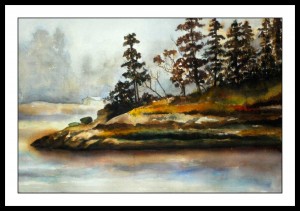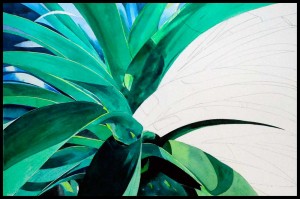I have continue with the watercolor painting of the red brick house which is done on 140 lb cold press watercolor paper. Red brick painted with mixture of Burnt Sienna, Yellow Ochre etc all of Winsor and Newton Watercolor paint is being used. Wet in wet technique was used in the beginning. Later, dry brush technique is used for the texture of the brick. The top left corner of the window was painted first and below it I started off with a dark earth watercolor and later the cross window screen was lift off with a wet brush. Right side window was painted with mixture of Winsor Green, Ultramarine Blue and Winsor Violet with a touch of grey.
Tag Archives: dry brush
Old brick house and window watercolor painting – 7 x 11 inches
This is a small watercolor painting of an old brick house and a window surrounded by green plants. The painting is approximately 7 x 11 inches and is painted on cold press watercolor paper. A blue green wash compose of Ultramarine Blue and Windsor Green watercolor paint is applied on where the plant is going to be. Then the leaves are painted in a darker watercolor tone. After the layers are dry, a thin wash of Burnt Sienna watercolor is used for the wall color behind the plant. Left wall is being painted with several watercolor washes along side several watercolor washes for the plant. The right side showing the thin watercolor washes in contrast with the left. Part of the window frame and the brick window sill is also being painted in several watercolor layers using the wet in wet as well as the dry brush technique for watercolor texture.
Daily Watercolor Painting – Island Mist – 15 x 22 inches landscape watercolor
This is the finished landscape watercolor painting and is called the Island Mist. It is based on a photo I took during my trip to Mayne Island on board of the BC Ferry. Mayne Island is an island in British Columbia between Vancouver and Victoria Island. This landscape watercolor painting is done on a 15 x 22 inches ( half sheet ) cold press watercolor paper using Winsor and Newton Artist watercolor. A background tonal study using Burnt Umber is put on initially and then the variious watercolor pigments was applied in layers. See my previous post for the Burnt Umber under painting. The colors I used for this painting mostly consists of Ultramarine Blue, Winsor Green, Burnt Umber and Alizarin Crimson. Basic watercolor wash as well as dry brush technique is used as well as splattering and salt effect.
Daily Watercolor – Ink Resist Technique – Dance Passion 1
Ink resist art technique involves permanent ink, watercolor, tempera, gouache or acrylic………………I use liquid frisket for other lines instead of painting around it. It proved to be an easier and faster method. So I painted all the lines with frisket and after it is dry, I painted the tempera on the whole painting. After the tempera is dry, all the frisket is removed showing the paper between the tempera. Permanent black liquid ink is then painted on the entire painting with a foam brush. This is the basic techique of Ink Resist art.
For illustration of the ink resist art technique, the above shows the tempera paint all covered by the black ink. The lines where the frisket were was also black but the ink is permanently on to the paper and will be showing after the washing step. The liquid fisket I use was Pebeo drawing gum. The black ink is a speedball superball black india ink. I remove the green tape around the painting and free it from the backing board. The ink resist painting was left to dry and the next stage is to wash away all the black ink as well as most of the tempera paint.
Daily watercolor painting on green plant – A Green World
Having lots of fun continuing the 15 x 22 inches watercolor painting of a green plant. Although I can see there are areas in the painting that I need to change, I feel that this painting is progressing along quite well. These changes will be applied later at the end. One thing I found that the texture of the leaves are a challenge to show on the painting. Some areas I need to do more with the dry brush and the watercolor medium just would not allow errors in that regard. Also I must make sure that the underlaying value is correctly placed before I can work on the details.
Watercolor painting – Study of dry brush technique
I have recently read an article written by Peter V. Nielsen on drybrush technique. The title of the article is Drybrush – a watercolour technique explored by Andrew Wyeth. I find it very interesting that Andrew Wyeth divide his watercolor into plain watercolor and dry brush. He might start with plain watercolor techique but changes partly or fully into this more expressive dry brush technique. After I read Peter Nielsen’s article and the Wood Stove painting by Andrew Wyeth in 1962, I want to try this myself but could not find much information on the web about this technique.
Then I found a site by an artist in Trento Italy called Ottorino De Lucchi. He has develope a dry brush technique over the years which allows the painting to maintain the brightness of the watercolor. I saw his paintings on the web and it amazes me with the detail and brightness of it that I want to try it myself. So I read his article on the technique which he generously share and started with a small study of a pear. I have started with the dry brush technique he mentioned with layers and layers of dry color right from the palette but the result was needless to say, quite disappointing. I have put layers upon layers of color to build it up as in Ottorino’s instruction but still I am not happy with the result. I found that this technique is very time consuming and I have much to learn and to study about this dry brush watercolor technique. Nevertheless I will try to finish this study in a few days and keep it as reference for my future watercolor technique. Well, here it is showing my unsuccessful attempt on learning the dry brush technique. I will write about it tomorrow and show my finish watercolor study tomorrow.







